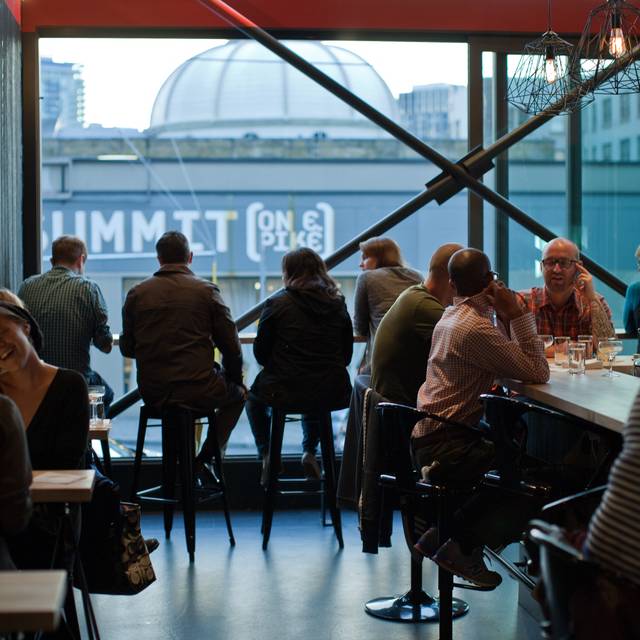
Yet after a couple of well-crafted cocktails - some of the best in the Bay Area - that probably doesn't matter to most people, especially those gathered around the bar drinking rather than eating. It's admirable to incorporate the building's past into the decor, but the slabs of marble are so big that it makes sitting at the eight-seat communal tables awkward.
/cloudfront-us-east-1.images.arcpublishing.com/dmn/IGKI6PRPRVFFBAG4NACS5XWBII.jpg)
Large brown leather tufted booths surround gray marble tables recycled from the building. One thick plaster wall features a black-and-white painting of the back of a nude woman it runs the length of the bar. Located in the historic Pacific Telephone building, an Art Deco structure at 140 New Montgomery St., the interior has a retro modern vibe. The space is alluring, but not altogether comfortable - it's like a woman who doesn't have the prettiest face but still attracts attention for how she puts herself together. It would be a robust addition to a city with a long legacy in skyscraper lore.The food embraces you like a warm hug. “That’s where the second tower was originally going to be, so we want to have something of prominence.” SKYSCRAPERS GET BIGGER OVER THE YEARS “We are hoping to do a significant office building and a hotel,” he told the newspaper. He said the new building mostly would be office space. “We are trying to pump up the density a little bit. We’ve got all the height we need.” President Neal Sleeper told the Morning News. “It’s one of the last two sites we have left,” CityPlace Co.


has asked the city of Dallas to approve construction of a project that is larger than the current zoning allows, the Morning News reported. “We are trying to pump up the density a little bit. We’ve got all the height we need.”ĬityPlace Co. Highland Capital Management recently bought the 1.4 million-square-foot CityPlace Tower, the tallest building in Dallas outside the urban core. The second edifice was never constructed, the Morning News said. The planned tower on a 2.5-acre site originally was earmarked for a 42-story building in the 1980s as a twin for the landmark CityPlace Tower that recently changed hands in a major acquisition. The Dallas Morning News has reported that a new skyscraper might be in line for the CityPlace development along Central Expressway-if plans being pitched by property owner CityPlace Co. It should be completed in 2019.Īnd, there may be another towering building on the horizon. It opened in 2013.īut, Commercial Café’s chart (below) on the tallest buildings under construction by city is a little short-562 feet short, to be exact.ĪMLI Fountain Place tower in downtown Dallas was begun in September 2017, and it will be a 562-foot, 46-story building nestled next to the recently renovated 720-foot, 62-story Fountain Place tower on Ross Avenue downtown. The publication said that the 560-foot, 42-story residential Museum Tower was the last skyscraper to open since 2000.

In 2014, readers of USA Today voted Dallas as the Best International Skyline.Ĭonstruction of new towering buildings slowed in recent decades from is heyday in the 1980s when 10 of the city’s tallest buildings were built, Commercial Café said. Over the years, new skyscrapers have added to Dallas’ image as a robust hub for business and aesthetically compelling buildings. Of the 16 Dallas skyscrapers Commercial Café credits in the current skyline, the 921-foot, 72-story Bank of America Plaza is the tallest. In a new article comparing skyscraper construction now to its boom days of the ’80s, Commercial Café reported that Dallas is one of 18 cities that boast at least five skyscrapers - buildings with at least 40 stories and at least 500 feet in height. Two recent reports got us thinking: Are skyscrapers still a force in Dallas’ present and its future? The project’s completion deadline is 2020. With the announcement of Texas’ largest adaptive redevelopment project -a $450M revival of the 52-story, First National Bank Tower-the technology of tall is in focus for Todd Interests. The skyline of Dallas has been the symbol of a city on the rise since its first so-called skyscraper, the Praetorian Building at Main and Stone streets, was constructed in 1909.Īs the city grew and the definition of skyscrapers changed, Big D built on its reputation for big towers reaching ever higher into the even bigger North Texas sky.


 0 kommentar(er)
0 kommentar(er)
